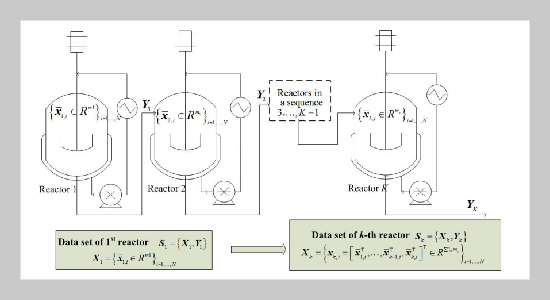REFERENCES
- [1] Manabu Kano and Koichi Fujiwara. Virtual sensing technology in process industries: Trends and challenges revealed by recent industrial applications, 2013.
- [2] Bahareh Bidar, Jafar Sadeghi, Farhad Shahraki, and Mir Mohammad Khalilipour. Data-driven soft sensor approach for online quality prediction using state dependent parameter models. Chemometrics and Intelligent Laboratory Systems, 162:130–141, 2017.
- [3] Francisco A A Souza, Rui Araújo, and Jérôme Mendes. Review of soft sensor methods for regression applications. Chemometrics and Intelligent Laboratory Systems, 152:69–79, 2016.
- [4] Yanmei Meng, Qiliang Lan, Johnny Qin, Shuangshuang Yu, Haifeng Pang, and Kangyuan Zheng. Data-driven soft sensor modeling based on twin support vector regression for cane sugar crystallization. Journal of Food Engineering, 241:159–165, 2019.
- [5] Kai Sun, Xiuliang Wu, Jingyu Xue, and Fengying Ma. Development of a new multi-layer perceptron based soft sensor for SO2 emissions in power plant. Journal of Process Control, 84:182–191, 2019.
- [6] Senqi Xu and Xinggao Liu. Melt index prediction by fuzzy functions with dynamic fuzzy neural networks. Neurocomputing, 142:291–298, 2014.
- [7] Taoyan Zhao, Ping Li, and Jiangtao Cao. Soft sensor modeling of chemical process based on self-organizing recurrent interval type-2 fuzzy neural network. ISA Transactions, 84:237–246, 2019.
- [8] Sreˇcko Herceg, Željka Ujevi´c Andriji´c, and Nenad Bolf. Development of soft sensors for isomerization process based on support vector machine regression and dynamic polynomial models. Chemical Engineering Research and Design, 149:95–103, 2019.
- [9] Mingming Zhang and Xinggao Liu. A soft sensor based on adaptive fuzzy neural network and support vector regression for industrial melt index prediction. Chemometrics and Intelligent Laboratory Systems, 126:83– 90, 2013.
- [10] Qi Li, Liping Xing, Wenya Liu, and Wei Ba. Adaptive Soft Sensor Based on a Moving Window Just-intime Learning LS-SVM for Distillation Processes. IFACPapersOnLine, 48(28):51–56, 2015.
- [11] Chao Shang, Xinqing Gao, Fan Yang, and Dexian Huang. Novel bayesian framework for dynamic soft sensor based on support vector machine with finite impulse response. IEEE Transactions on Control Systems Technology, 22(4):1550–1557, 2014.
- [12] Wentao Ma, Jiandong Duan, Weishi Man, Haiquan Zhao, and Badong Chen. Robust kernel adaptive filters based on mean p-power error for noisy chaotic time series prediction. Engineering Applications of Artificial Intelligence, 58:101–110, 2017.
- [13] Ibtissam Constantin and Régis Lengellé. Performance analysis of kernel adaptive filters based on LMS algorithm. In Procedia Computer Science, volume 20, pages 39–45, 2013.
- [14] Haowen Zhou, Jinquan Huang, and Feng Lu. Reduced kernel recursive least squares algorithm for aeroengine degradation prediction. Mechanical Systems and Signal Processing, 95:446–467, 2017.
- [15] Steven Van Vaerenbergh, Javier Vía, and Ignacio Santamaría. A sliding-window kernel RLS algorithm and its application to nonlinear channel identification. In ICASSP, IEEE International Conference on Acoustics, Speech and Signal Processing - Proceedings, volume 5, 2006.
- [16] Steven Van Vaerenbergh, Ignacio Santamaría, Weifeng Liu, and José C. Príncipe. Fixed-budget kernel recursive least-squares. In ICASSP, IEEE International Conference on Acoustics, Speech and Signal Processing - Proceedings, pages 1882–1885, 2010.
- [17] Badong Chen, Songlin Zhao, Pingping Zhu, and José C. Principe. Quantized kernel least mean square algorithm. IEEE Transactions on Neural Networks and Learning Systems, 23(1):22–32, 2012.
- [18] Min Han, Shuhui Zhang, Meiling Xu, Tie Qiu, and Ning Wang. Multivariate chaotic time series online prediction based on improved kernel recursive least squares algorithm. IEEE Transactions on Cybernetics, 49(4):1160–1172, 2019.
- [19] Min Han, Junzhu Ma, and Shunshoku Kanae. Time Series Online Prediction Based on Adaptive Dynamic Adjustment Kernel Recursive Least Squares Algorithm. In 9th International Conference on Intelligent Control and Information Processing, ICICIP 2018, pages 66–72, 2019.
- [20] Haowen Zhou, Jinquan Huang, and Feng Lu. Parsimonious kernel recursive least squares algorithm for aero-engine health diagnosis. IEEE Access, 6:74687– 74698, 2018.
- [21] Yaakov Engel, Shie Mannor, and Ron Meir. The kernel recursive least-squares algorithm. IEEE Transactions on Signal Processing, 52(8):2275–2285, 2004.
- [22] Cédric Richard, José Carlos M Bermudez, and Paul Honeine. Online prediction of time series data with kernels. IEEE Transactions on Signal Processing, 57(3):1058– 1067, 2008.
- [23] Weifeng Liu, Il Park, and José C. Príncipe. An information theoretic approach of designing sparse kernel adaptive filters. IEEE Transactions on Neural Networks, 20(12):1950–1961, 2009.
- [24] Bas J De Kruif and Theo J A De Vries. Pruning error minimization in least squares support vector machines. IEEE Transactions on Neural Networks, 14(3):696– 702, 2003.
- [25] Yi Liu, Naiping Hu, Haiqing Wang, and Ping Li. Soft chemical analyzer development using adaptive leastsquares support vector regression with selective pruning and variable moving window size. Industrial and Engineering Chemistry Research, 48(12):5731–5741, jun 2009.
- [26] Yi Liu, Zengliang Gao, and Junghui Chen. Development of soft-sensors for online quality prediction of sequential-reactor-multi-grade industrial processes. Chemical Engineering Science, 102:602–612, 2013.
















